► CAR’s exclusive access to VW’s Wolfsburg home
► 50 years of Golf keeps factory going
► We talk past, present and future of Golf with design boss
There’s a rhythmic, pounding rumble that’s gently but persistently shaking the ground around me. It starts not long after I enter the biggest factory building I’ve ever been in, and it’s getting louder as I venture further in. It’s ominous, bassy and regular like an amplified yet distant heartbeat – and gives the impression I’m exploring a place that’s organic, rather than industrial.
I’ve been given exclusive access to Volkswagen’s vast Wolfsburg facility as it celebrates the Golf’s 50th anniversary. Wolfsburg isn’t just Volkswagen’s headquarters but its constant, its keystone and a near-indestructible core for a brand that’s had to ride out considerable turbulence – plenty of it its own doing – over recent years. Dieselgate-influenced strategies to electrify quickly have meant a lukewarm start for its ID range of cars and dwindling EV production; it’s been beset in China by home-grown car makers toppling its number one sales position; management reshuffles have meant uncertainty in the brand’s future direction and CEO Thomas Schäfer reportedly told senior management ‘the roof is on fire’ in the summer of 2023. Since this feature was originally published in print in July 2024, Volkswagen’s fortunes have arguably gotten even worse, as it considers its production future in Germany, much to the understandable furore of the brand’s huge workforce in its home country.
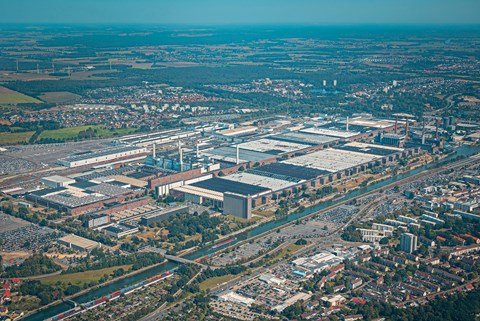
And yet the Wolfsburg facility remains. Endures. Thrives, even.
This is and always has been the Golf’s home, kicking off production in 1974 and never stopping – and plans are already in place to carry on well into the 2030s. Schäfer has previously confirmed to CAR that the ninth-generation Golf will launch in 2028, arriving with petrol engines and going electric – still badged Golf, without any ID branding. By then it will be running on the VW Group’s Scalable Systems Platform (SSP) – an architecture that will be able to underpin anything from an EV city car right up to a super-powered performance grand tourer. GTI and R will electrify, too, with the first electric R product being the ninth-generation Golf’s R version, which will also be built in Wolfsburg.
Nothing prepares you for the sheer scale of the operations here. To help get a handle on it all, I have the best tour guide you could ever ask for: Andreas Mindt. I’d argue few are more passionate about the Golf’s past, present and future than Mindt, who just so happens to be VW’s head of design (his previous post was Bentley, where he sculpted the new Continental GT) and the man responsible for the Golf’s future direction.
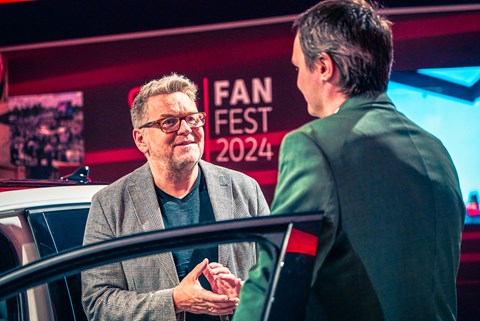
Spend time with Mindt and all that pressure doesn’t seem to manifest. He’s warm, chatty, affable and extremely knowledgeable. And, as it turns out, a big fan of CAR: ‘The Good, The Bad and The Ugly! Such a great signature, I always remember that,’ he says. I ponder whether perhaps GBU is our Golf; an ever-evolving constant in a familiar brand.
Mindt has Wolfsburg and Volkswagen in his blood. ‘I grew up in this city, and my father lived in Wolfsburg too,’ he says. ‘My father moved from Opel to Volkswagen in 1974 – I was five years old then, and he took me to the cinema to see Herbie, which was the first time I had seen a movie in colour. After seeing that, I just wanted to draw Beetles all of the time, so coming back to Volkswagen… this role is just fantastic for me.’
‘Back’ to VW? Yes, before stints at Audi and Bentley, Mindt cut his teeth working on the Mk5 Golf with the likes of Marc Lichte (former Audi design director) and Peter Schreyer (designer extraordinaire who went on to spearhead an aesthetic transformation at Kia). The rear light design used for the production car was his own doing. Since then, he’s been involved in elements of the Mk6 and Mk7.
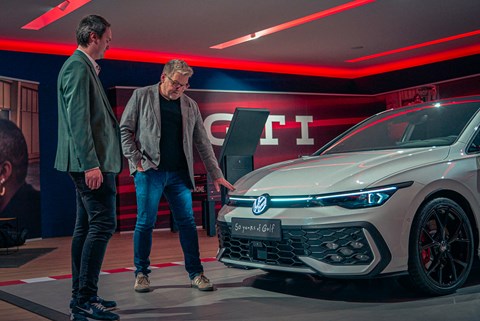
But Mindt knows the task before him as head of design. The most recent iteration of Golf – the Mk8 – hasn’t been as well received as its predecessor, mostly down to the user interface, but its odd looks won’t have helped. ‘Taking over this responsibility [for the Golf’s design direction] is a big thing. I enjoy it, but I do feel it. We have to improve the design now and bring the Golf back to its former glory,’ he says. As VW has focused on electrifying with its ID range, Mindt acknowledges the Golf has been neglected. ‘We have to go back to it. It’s like the Porsche 911 – it’s the heart of the brand. We have to treat it better, give it the right stage. We’re going into the next era with it now, and we need to transform it but keep those fundamentally approachable, likeable but strong characteristics.’
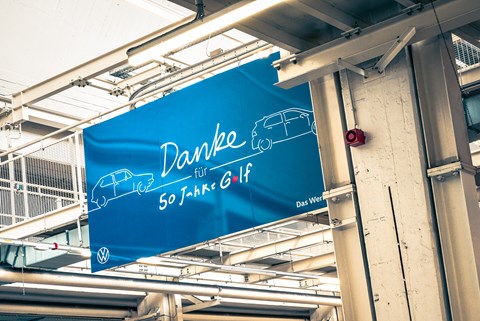
As I wander the factory halls, it’s clear that this isn’t just any old workforce assembling any old product. As well as those ‘50 jahre’ banners and signs, there are temporary mini-museums showing off all eight generations to the employees, allowing them to get a dose of the car’s history during their breaks. There’s passion here, even if the Golf is a resolutely sensible family car sold by the million and not some halo supercar that you might put a poster of on your bedroom wall. That doesn’t matter to our tour host: ‘For me, the Golf is a supercar but in conventional form.’ And he notes that although the Golf is built in huge quantities, no car starts its journey through the factory without an order behind it.
Finally I find the source of that rhythmic, earth-shaking thunder. It’s a metal pressing machine in the press shop – only this one is the size of a three-storey apartment block, busy punching out front wings for the Golf. As it presses out part after part, accompanied by that bassy drum beat, it’s almost hypnotising to watch. Every working day in the press shop needs around 2600 tonnes of steel, and the pairs of casts needed to press certain parts (the lower is called the ‘die’ and the upper ‘punch’) weigh 50 tonnes a pair. And yet changing them takes just 10 minutes. Standing next to this behemoth of a machine while it’s working is a brief taste of what goes on here day after day, week after week, all year round.
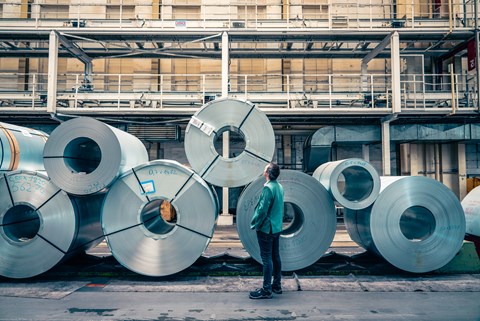
Wolfsburg proudly holds the title of the largest car factory in the world and has the stats to back it up. It takes up 2.6 square miles of land and manages to look like a city all on its own (despite being attached to one), features 47 miles of roads and 37 miles of railway lines, and it has its own internal bus network just for employees to get around – so much so that there are fantastic bus stop signs that show what factory buildings make what car. You can jump on at a Golf bus stop and be dropped off at the Tiguan line, for example.
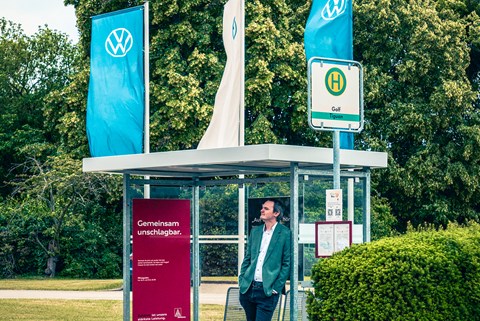
Rolls of steel in the press shop – stacked two-up – are each taller than I am, and need the massive cranes you normally only see at shipping ports. Armies of buggies, carts towing trailers filled with components, individual workers zipping around on cycles and autonomous pods all dance around each other like a precisely choreographed industrial ballet. Robots on the production line are so large they’d defeat Thor in an arm-wrestling contest. There’s a location where marriage between powertrain and bodyshell happens every few minutes.
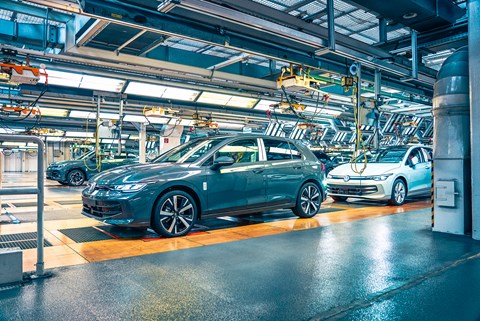
Many end up at the Autostadt – the massive complex attached to the factory that houses museums, pavilions for all of the VW Group brands to show off their latest models and the two cylindrical towers that act as massive vending machines filled with customer cars awaiting delivery. Around 70,000 people work across the whole Wolfsburg facility – a number that even includes VfL Wolfsburg, the factory’s own, currently in-form football team.
Volkswagen is more than happy to make a song and dance about you getting your new car. As well as collecting your new model straight out of the Autostadt towers, you’re welcome to take a tour of the factory yourself. We’re given the special treatment in a bespoke Touran that’s had its roof carefully chopped off, and regular tours are done using ID. 3s towing carriages of people through the factory floors. Hell, VW will even give you a pack or two of its own-recipe currywurst for the road; the product coded 199 398 500 A is VW’s most popular component, with 8.3 million produced in 2023.
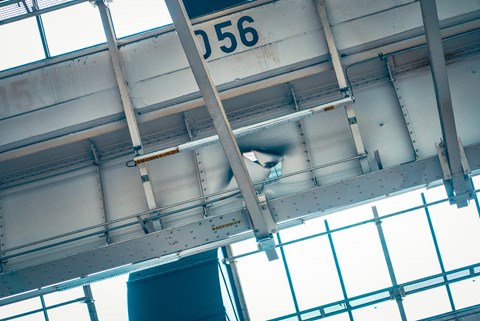
It doesn’t hide its history. Volkswagen and its Wolfsburg home were created under the Third Reich in the run-up to war and still, to this day, wear battle scars from the conflict. Look hard enough and you’ll spot a few steel support structures (thankfully reinforced in other ways) peppered with shrapnel holes from Allied bombing runs all those years ago. There’s even a steel press that went into service in 1939 that’s still functional and stands proudly among the much more modern machinery.
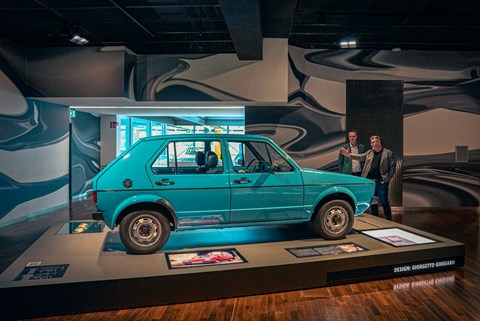
Mindt and I spend some time in the ZeitHaus, – a modern structure in the Autostadt that acts as a museum not just for Volkswagen, but for notable firsts in the automotive industry – and here you can just wind Mindt up and watch him go. He rattles off fact after fact about the exhibits – Volkswagen or otherwise – but it’s not some tour he’s rehearsed, he just knows his stuff, and it’s all fascinating. Here, the Golf’s immense flexibility and usability are on show. There’s a gorgeously retro Mk2 Country, for example, which Mindt claims was the first SUV – ‘farmers and hunters bought them in Germany!’ – and not far away is the mutant GTI W12 that leveraged the VW Group’s flagship engine.
As we sit down for a drink at his favourite haunt in Wolfsburg – Erste Sahne in the Autostadt – I quickly realise he is as fascinated and enthusiastic about coffee as he is about cars. He tells of how Wolfsburg has quite a large Italian community that has influenced good coffee in the area, and that it’s the best around. ‘I also had a proper coffee machine when I used to work at Audi,’ he says. That, I say, must have been pretty noisy. He admits it was: ‘Oh yeah, it was! I had this dream of offering it to guests but couldn’t keep up with the effort – and the mess!’
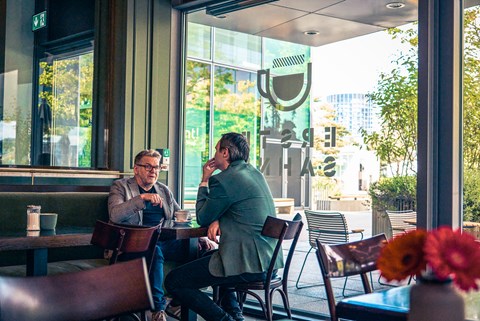
Enjoying Erste Sahne’s coffee and looking out of the window, we spot a father loading his kids into a heavily modified Mk7 GTI Clubsport S – almost perfectly timed to underline the point about the Golf’s flexibility. ‘He clearly has good taste,’ smiles Mindt. ‘That is the beauty of Golf. It’s hands-on and approachable and yet can be really, really special every day.’
Mindt’s enthusiasm comes to a head when we meet Torben Rühmann, a member of his design team who owns an immaculate Mk1 Golf Cabrio. It was originally a Quartett edition with a white interior, but it has been restored by Karmann and Cabriozentrum in Osnabrück with a sumptuous new caramel hue and matching roof. The paint and wheels are factory fresh, and the owner is besotted.
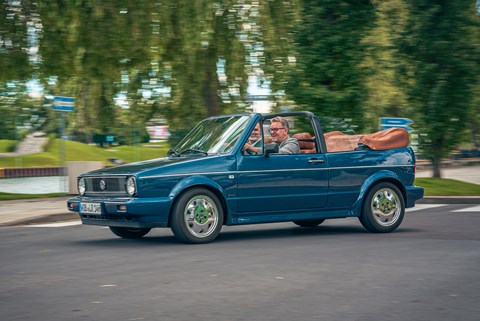
Now, seemingly, so is Mindt – I can see in his eyes that he’ll be pondering the classifieds for one of his own after we’re done here (he owns a Beetle and a Bentley Arnage, and a well-used Mk8 Golf GTI Clubsport as a company car). He loves these cars, and knows them inside out. When there’s a brief hiccup starting the Cabrio, Mindt is quick with knowledge and advice, pointing out that models of that particular year of production sometimes had issues where air bubbles could develop in the fuel mixture when the car had been driven, turned off and restarted. Not every designer would know that about a car from their company’s back catalogue.
Out on the road, the Golf is a bundle of joy. The Cabrio’s four-cylinder engine gently thrums as we whizz past Autostadt buildings, seeing the site from a different perspective. Riding shotgun alongside Mindt is a neat reminder of the Golf’s place in the world. Despite this Mk1 example being more than 40 years old, elements of its interior feel like they still belong in Golfs three generations newer, which backs up Mindt’s mantra regarding Golf design: timelessness. ‘You have to remember, the Golf was following on from another timeless car,’ Mindt points out. ‘I’d say the first-generation Golf was really brave, moving on from a rear engine in the Beetle to a front engine. At that time, it was a crazy decision, but it needed doing. The Beetle was a golden cow; nobody wanted to slaughter it because it was still a success. But not changing something for so long, even if it’s successful, can be a problem.’
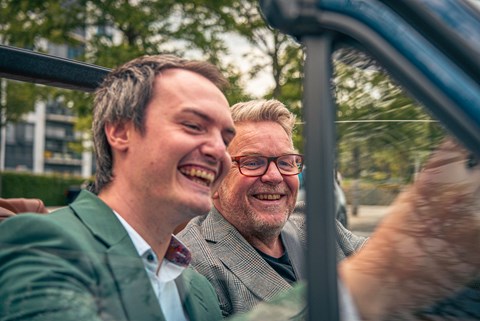
Being at the wheel, you can tell the memories of younger days are flooding into Mindt’s mind; he tells me of his time attending Coventry University’s automotive design classes on an exchange programme, and says: ‘I remember when these were new, and now they’re a vintage car, does that mean I’m vintage now, too?!’ He’s laughing, but he has a serious point to make about the long afterlife of a successful car. ‘Everybody has memories of the past, but what about the next ones? Who is taking care of the future memories? The young children in the back of that Clubsport? The guy with his restored Mk1 Cabrio? The Golf is a mass-production thing, but the aim is to make it individual to everybody.’
It’s a tumultuous period for Volkswagen. But with the company committed to Golf for at least another generation at Wolfsburg, and with someone as passionate and Golf-literate as Andreas Mindt leading the model’s future direction, it’s a fair bet that car, company and factory will all keep steadily pounding away for years to come.
This feature was originally in the September 2024 issue of CAR. Want access to more exclusive features? Click here to find out how to become a CAR member!